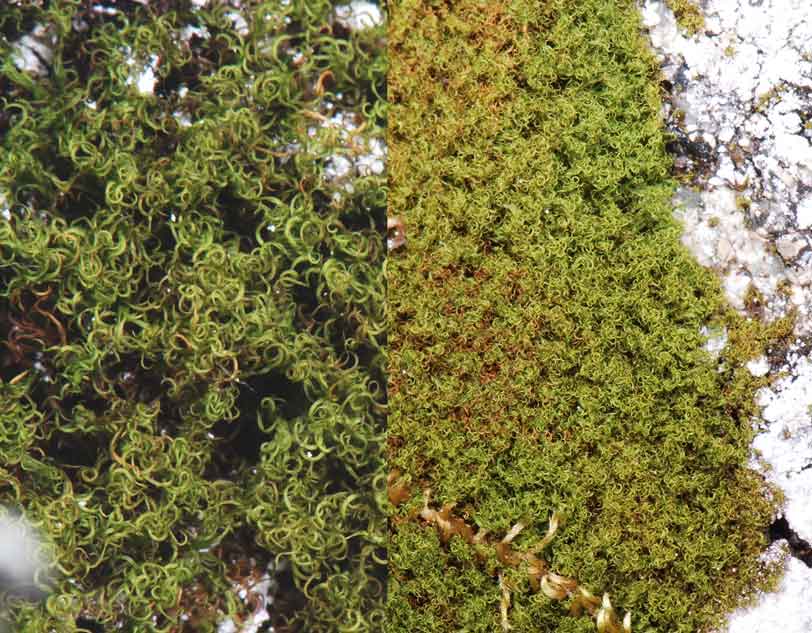Amphidium W. P. Schimper, 1856.

Amphidium californicum, photo by Wilson of Coleman 152
Amphidium is exclusively a moss that grows on rather shaded rock faces, crevices and under protected overhangs. Typically it forms tight clumps of plants with elongate and crispate leaves. The basal cells are elongate with marginal cells somewhat more narrow than the cells half way to the costa. There is no alar differentiation. Amphidium in our region is only occasionally with sporophytes but those sporophytes easily signal the identification by their sulcate and gymnostomous capsules emergent to almost immersed on a short seta.
Key to Amphidium Etc.
The mosses in this key are acrocarpous plants with very narrow and strongly crispate leaves with cuticular papillosity on the essentially isodiametric cells of the lamina. Papillae formed from such sculpturing of the cuticle are uncommon among California mosses with possible confusion coming only from Dicranoweisia contermina and from Plagiopus oederianus (the latter not yet known from California). The papillosity of Amphidium appears as bumpy ridges that run the length of the leaves and appear unrelated in placement to the placement of the cell end-walls. This pattern differs from normal papillosity that appears to arise from over the cell lumina as seen from vertical view.
Species included in this key are in Rhabdoweisiaceae, except Dicranoweisia (Seligeriaceae):
Amphidium californicum (Hampe ex C. Müller Hal.) Brotherus
Amphidium lapponicum (Hedwig) W. P. Schimper
Amphidium mougeotii (Bruch & W. P. Schimper) W. P. Schimper
Dicranoweisia contermina Renauld & Cardot
2008 KEY, P. Wilson
A. Leaf margins bistratose at mid-leaf; costa short-excurrent; immediate supra-basal marginal cells with thin lateral walls compared to the thick transverse walls .....Dicranoweisia: D. contermina
A. Leaf margins unistratose throughout; costa ending within one or more cells of leaf apex; immediate suprabasal marginal cells without strong difference between lateral and transverse wall thickness .....B
B. Leaves not crispate; leaf apices with clusters of green gemmae; basal marginal cells quadrate with transverse walls thicker than lateral walls .....Grimmia: G. anomala
B. Leaves strongly crispate; gemmae absent; basal marginal cells elongate with lateral and transverse walls evenly thin .....C
C. Margin serrulate with teeth remote from one another; basal juxtacostal cells primarily about 3-5:1; restricted to low elevations .....Amphidium californicum
C. Margin entire; basal juxtacostal cells primarily about 2-3:1; typically montane in California .....D
D. Perichaetial leaves sheathing with apex abruptly contracted into a short apiculus; seta about as long as capsule; synoicous; leaves a bit shorter (more lanceolate than linear) and more strongly crisped when dry; leaf margins only slightly recurved; supposedly with cuticular papillae larger but one would have to standardize the part of the leaf under observation .....Amphidium lapponicum
D. Perichaetial leaves longer and only gradually tapering; seta longer; dioicous; leaf margins more consistently recurved throughout a greater length of the leaf; leaves longer (more linear than lanceolate) and less strongly crisped when dry; cuticular papillae smaller .....Amphidium mougeotii, fertile material not yet found in CA, thus confirmation for CA not completely resolved

